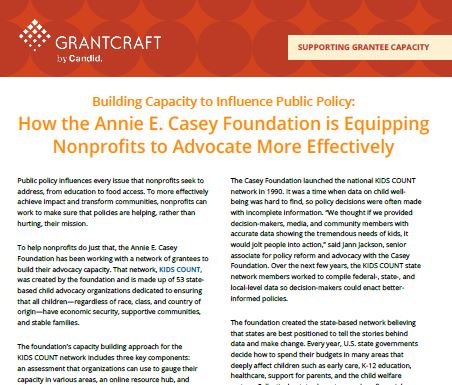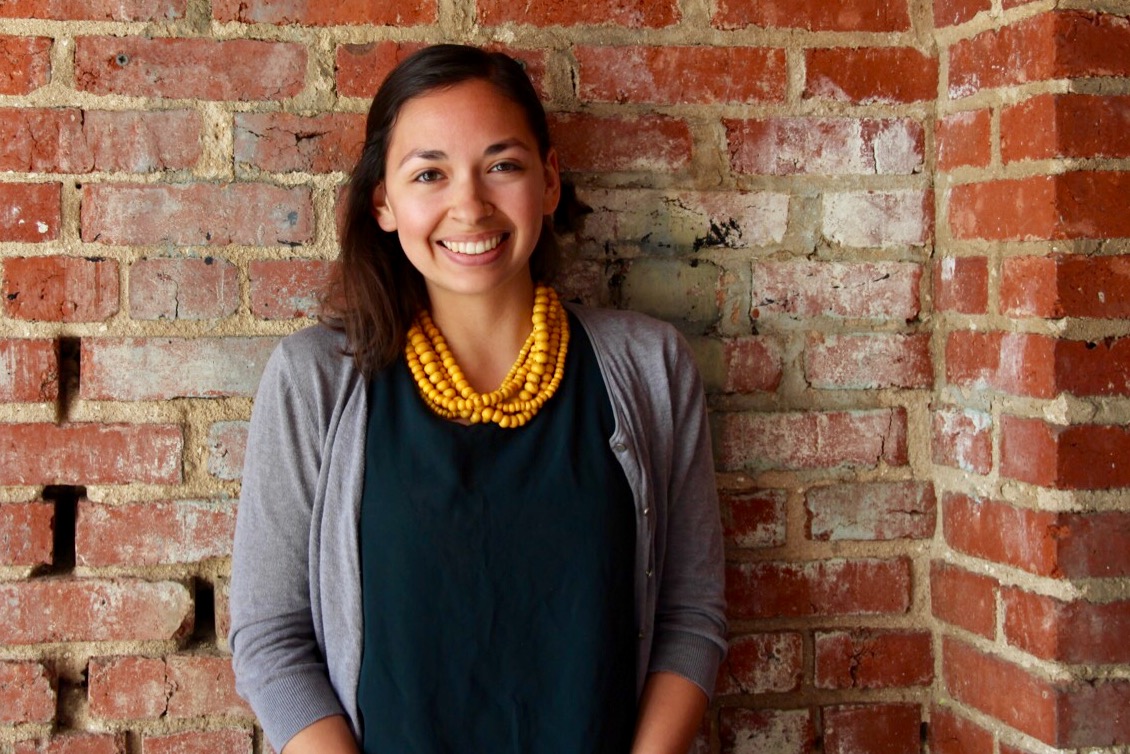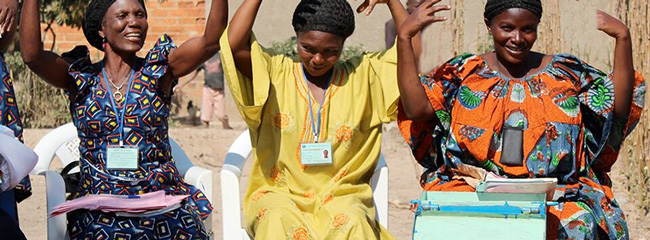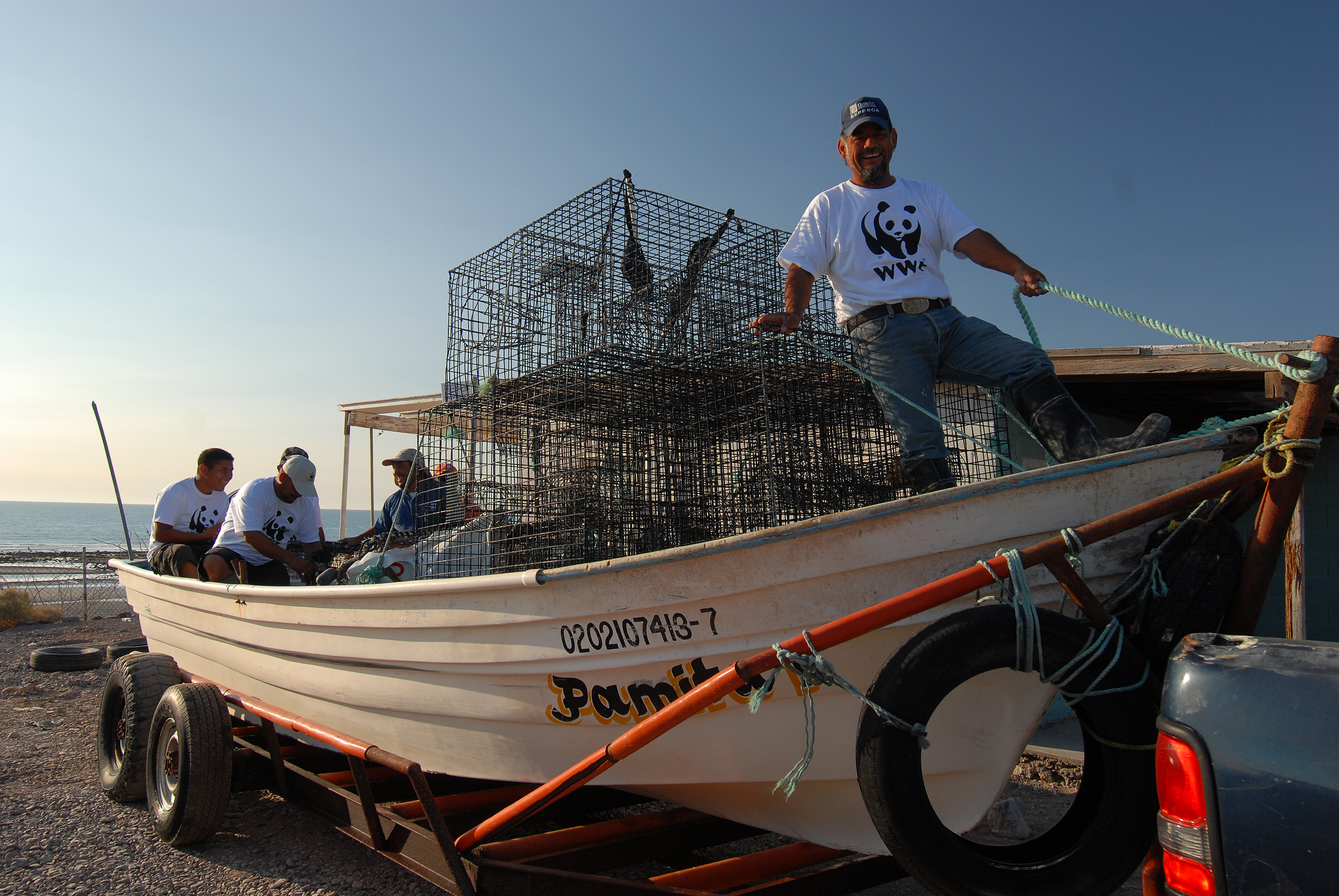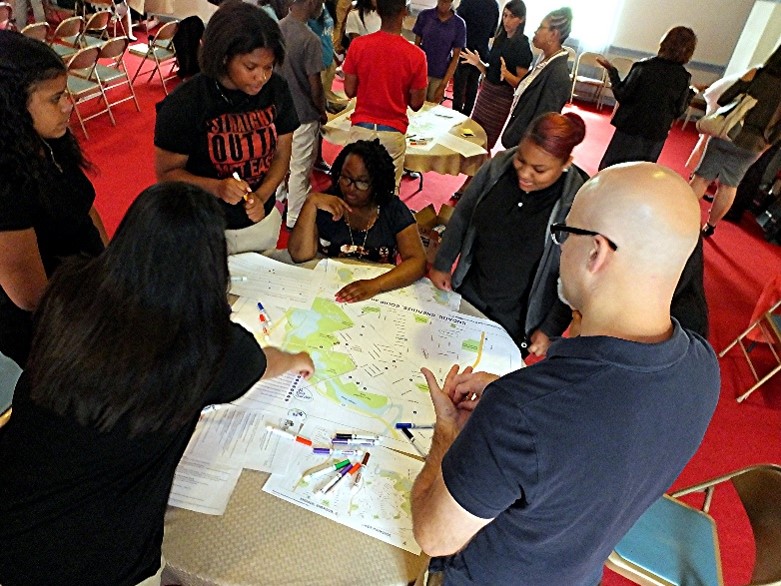Building Capacity to Influence Public Policy: How the Annie E. Casey Foundation is Equipping Nonprofits to Advocate More Effectively
Editor's Note: This case study is one of five in a suite of case studies focused on building grantee capacity using the support of consultants. Each case study has been developed in partnership Community Wealth Partners, drawing on their capacity-building work with various funders and grantees. The case studies showcase varied approaches taken to address the long-term capacity needs of grantees, giving insight to the philanthropy landscape and strategies for foundations, consultants, and practitioners.
Public policy influences every issue that nonprofits seek to address, from education to food access. To more effectively achieve impact and transform communities, nonprofits can work to make sure that policies are helping, rather than hurting, their mission.
To help nonprofits do just that, the Annie E. Casey Foundation has been working with a network of grantees to build their advocacy capacity. That network, KIDS COUNT, was created by the foundation and is made up of 53 state-based child advocacy organizations dedicated to ensuring that all children—regardless of race, class, and country of
origin—have economic security, supportive communities, and stable families.
The foundation’s capacity building approach for the KIDS COUNT network includes three key components: an assessment that organizations can use to gauge their
capacity in various areas, an online resource hub, and targeted technical assistance. Grantees seek to improve not only their advocacy capacity but also other capacities that affect their ability to make policy change, such as leadership. This approach is making a measurable difference in network members’ ability to influence public policy and reach kids and families.
How Advocacy Became Central to Kids Count
The KIDS COUNT network—which includes one member from all 50 U.S. states, Puerto Rico, the U.S. Virgin Islands, and the District of Columbia—hasn’t always focused so intently on advocacy. Initially, the network focused more on data.
The Casey Foundation launched the national KIDS COUNT network in 1990. It was a time when data on child wellbeing was hard to find, so policy decisions were often made with incomplete information. “We thought if we provided decision-makers, media, and community members with accurate data showing the tremendous needs of kids, it would jolt people into action,” said Jann Jackson, senior associate for policy reform and advocacy with the Casey Foundation. Over the next few years, the KIDS COUNT state network members worked to compile federal-, state-, and local-level data so decision-makers could enact better-informed policies.
The foundation created the state-based network believing that states are best positioned to tell the stories behind data and make change. Every year, U.S. state governments decide how to spend their budgets in many areas that deeply affect children such as early care, K-12 education, healthcare, support for parents, and the child welfare system. Collectively, states have tremendous financial power: In 2016, the 50 U.S. states and the District of Columbia spent $1.2 trillion in state revenues, as a Center on Budget and Policy Priorities report shows.
After leading a competitive request for proposals process between 1990 and 1995, the foundation selected multi-issue child advocacy organizations, mostly nonprofits but
also some universities and smaller foundations, to join the network. The foundation looked for organizations that didn’t rely on state funds with the belief that they would have more independence to publish data—positive or negative—and would have more capacity to focus solely on the best interests of children. All the KIDS COUNT network members received $75,000 each year to collect data, make it publicly available, and develop their own state-level data book with specific data about children and families within their own communities. Each year they helped disseminate the annually updated national KIDS COUNT Data Book. Starting in 2014, as the foundation recognized the power of the network, network members began receiving $100,000 from the foundation to further strengthen their data-informed policy advocacy. Most organizations have been in the network for decades: since 2009, 42 of the 53 network members have remained the same. The organizations who leave the network typically do so because they fail to fulfill their obligations. When this occurs, new state partners are identified and supported.
After two decades of doing this work, the network had seen positive change. For example, a majority of members successfully advocated for their states to adopt the federal Children’s Health Insurance Program, which has resulted in millions of children receiving health coverage. But when they weren’t seeing the full magnitude of potential change sought, the foundation acknowledged that data was necessary but not enough. “We realized about 10 years ago that if data alone was to change the debate, it would already be happening in multiple areas of public policy,” Jackson said. Network members needed to combine data with advocacy and strategic communications to shift public policy. Though many network members were already doing this, foundation support for state-level advocacy was limited.

The Casey Foundation funded network members’ efforts to update their organizations’ theories of change and was impressed and inspired by the outcomes. In 2010, the foundation worked with the network to adapt the broader KIDS COUNT theory of change to center around network members’ ability to influence policy. A key strategy of that theory of change is building the capacity of network members. The capacity building encompasses many things, from strengthening leaders to improving data analysis, but it all drives toward helping organizations advocate more effectively.
“We’re trying to improve capacity for a very specific gain: to support better policies that improve results for kids and their families,” Jackson said.
Grantee Requirements
The KIDS COUNT network maintains most of its 53 members year-over-year, though all grantees reapply to be part of the network each year. To remain a network member, grantees are expected to:
- Have a high level of credibility and respect
- Produce at least one data product annually and provide online access to updated state and local data (the development of a comprehensive data product on a bi-annual basis is required)
- Develop a data-informed policy agenda
- Partner with the foundation to release the national KIDS COUNT Data Book and at least one other national KIDS COUNT product
- Participate in foundation-sponsored institutes or other technical assistance opportunities on an annual basis
- Operate as a high-performing, race- and ethnicity- informed, and financially stable organization
- Enhance decision-makers, media, and the public’s knowledge and use of data
Assessing Strengths and Opportunities for Growth
The Casey Foundation has long invested in the capacity of its KIDS COUNT network, mainly through providing an annual conference, a data-focused institute, webinars, and state-specific technical assistance in data, communications, and organizational development. After the KIDS COUNT theory of change was updated, the foundation also revisited its capacity building approach and identified several opportunities for growth.

For one, the approach needed to more effectively help network members advocate for public policy change. The new theory of change meant that the focus was no longer just on reporting data but also communicating data in a strategic way to improve results for kids. This meant that network members not actively involved in advocacy would need assistance getting up to speed. The foundation had also seen varied performance of fundamental tasks across the network. Grantees most in need of support seemed the least likely to ask for help, out of concern that doing so would endanger their existing funding. When they did ask for help, it was often in moments of crisis, keeping the foundation responding to urgent needs rather than identifying and addressing root causes. Network members needed a way to proactively get support before needs became urgent and without fear of losing funding.
In 2011, the foundation created a working group of KIDS COUNT network members, Casey Foundation staff members, and professional capacity building consultants who had been working with the network. Their task boiled down to two main questions: “How do we figure out the attributes of a highly effective state advocacy organization, and how do we enable all KIDS COUNT organizations to achieve these attributes?” said Dennis Campa, associate director of policy reform and advocacy at the Casey Foundation.
First, the working group consulted with more than 40 individuals, including members of KIDS COUNT and other similar networks, to identify 90 competencies that are essential for a high-functioning child advocacy organization. The competencies—defined as knowledge, skills, and behaviors—were then organized into six core categories:
- Strategic leadership and decision making
- Organizational development
- Data analysis
- Policy advocacy and engagement
- Strategic communications
- Pursuit of racial equity and inclusion
These competencies gave network members shared language to identify and organize their needs so that the foundation could provide targeted capacity-building support. For years, the foundation and network both had been growing their racial equity capacity. The foundation and working group unanimously agreed that the network members’ missions would be impossible to achieve without addressing racial inequities, so they included sub-competencies around racial equity and inclusion for each core competency and also separated racial equity out into its own category.
The next step was to create a self-assessment that could provide all organizations in the KIDS COUNT network with a clear picture of their strengths and opportunities for growth. Given the inherent power dynamics between grantmakers and grantees, the Casey Foundation engaged a third party, social impact consulting organization Community Wealth Partners, to create and conduct the assessment and design a process that ensured network members were comfortable taking part.
“The Casey Foundation didn’t want grantees to feel there was any risk in being honest about where they are,” said Idalia Fernandez, senior director at Community Wealth Partners. “If grantees were worried that the assessment results would jeopardize their funding, that would really undermine the purpose.” 
Community Wealth Partners designed a process in which it would send grantees the self-assessment, collect and analyze their responses, and create two types of reports: 1) a report for the Casey Foundation that would show only aggregated information, which would inform the foundation’s decisions at the network level around technical assistance providers and topics for institutes, webinars, and new resources; and 2) individual organization reports for each respective organization’s executive director, which would include recommendations for improvement. The Casey Foundation would never see the individual organization reports, which Community Wealth Partners would provide only to an organization’s leaders.
The Casey Foundation recognized the need to be thoughtful about how they communicated this assessment to network members so that grantees would feel comfortable taking it and simultaneously not pressured to take it. Creating a confidential process was one thing; creating trust in that process was another. From the beginning, the foundation worked to reiterate its purpose: supporting grantees’ growth, not penalizing grantees for struggling. The foundation held informal conversations with network members to communicate its commitment to confidentiality and clarify what information the foundation would and wouldn’t be able to access. From those conversations, the foundation identified leaders that served on the national KIDS COUNT steering committee who were most enthusiastic about the assessment. The foundation asked steering committee members to help champion the tool among their peers, which helped uncertain network members feel greater confidence.
Meanwhile, Community Wealth Partners partnered with the KIDS COUNT steering committee to create the assessment while continuing to engage the broader network. They led an iterative process, consistently returning to network members for feedback and asking some network members to test a prototype. (See the Sample Capacity Indicator Tool developed by Community Wealth Partners in the PDF, available for download.)
The final assessment includes 92 questions about how strong an organization is within each of the six core competencies. When it’s conducted every two or three years, KIDS COUNT members ask their staff, board, and—occasionally—key partners to take the confidential survey. Community Wealth Partners then analyzes the data and creates reports.
Though the assessment is optional, 98 percent of network members took it in 2016, demonstrating the results of strong relationship building between the foundation, steering committee, and network.
“Taking the assessment provided us time to do our own reflection and get rich recommendations,” said Paola Maranan, a KIDS COUNT steering committee member and executive director of the Washington state-based Children’s Alliance. “It helped reinforce the sense that this work isn’t possible without the other organizational and strategic leadership components—the nuts and bolts of running an organization.”
Providing the Right Tools at the Right Time
Once organizations have data on their strengths and opportunities for growth, they can use that data to determine which competencies they want to home in on. Then the hard work of strengthening in those areas begins.
“You can have the best intentions, but without capacity and without long-term, patient investment in that capacity, you’re not going to get the outcomes you want,” Maranan said.
The Casey Foundation provides several ways for KIDS COUNT network members to make that long-term investment in capacity. One is the Advocacy Learning Lab, a virtual institute of free, online resources, tools, and technical assistance. Before the Advocacy Learning Lab existed, the foundation and its grantees had a wealth of resources scattered across hundreds of websites. KIDS COUNT members needed a one-stop-shop where they could easily access and navigate resources. The Advocacy Learning Lab was created in tandem with the assessment to be that one-stop-shop, to give network members a way to act on their assessment results, and to enable organizations to guide their own learning.
“The Advocacy Learning Lab was created to democratize capacity building,” Fernandez said.
The same six core competencies in the assessment form the backbone of the Advocacy Learning Lab. The website is organized by competency, and each competency has a narrative description of why it matters, how to get stronger, best technical assistance providers in that area, top five resources, and a longer list of related resources. There are over 1,300 resources on the site including:
- Monthly digests of resources (created by network members, staff of the Casey Foundation, and partners) for current policy threats and opportunities
- Relevant data to inform policy debates
- Strategic messaging guides to help citizens understand what is at stake
- Concrete strategies for advancing racial and ethnic equity in the policy arena
While the Advocacy Learning Lab is the self-serve option for capacity building resources, direct technical assistance offers more tailored and interactive support. The foundation engages about 20 technical assistance providers, each of whom supports network members in one or more of the six core competencies. Though grantees are typically limited to this list of providers, the foundation regularly gathers input and makes changes. For example, when grantees expressed a need for greater support in racial equity and inclusion, the foundation added more providers with that specific expertise. The Casey Foundation will also sometimes work with other networks—such as the Partnership for America’s Children and the State Priorities Partnership, which both have many of the same members—to ensure their grantees are getting the technical assistance support they need from at least one of the networks.
At the end of each year, network members submit requests for the type of technical assistance they want the following calendar year. The foundation then works to pair network members with providers and peers based on skillset and availability. The providers help organizations build their capacity to analyze data, create communications strategies, use research software, convene partners to push forward a policy agenda, understand how racial disparities show up in their state, and much more. The support includes in-person KIDS COUNT gatherings, webinars, and customized assistance to individual organizations and their leaders.
One type of technical assistance provided every year to all network members is around legal advocacy. Many foundations and nonprofits fear advocacy work because of uncertainties around what is legal or what may alienate supporters, but KIDS COUNT network members acknowledge and work through these challenges. To help network members do this, the Casey Foundation engages Alliance for Justice, a national association of 130 organizations that is the leading expert on the legal framework for nonprofit advocacy efforts. With support from the foundation, Alliance for Justice provides consultation to all network members on IRS guidelines for administrative, legislative, and electoral advocacy.
Using Data to Learn
Just as data is important in the KIDS COUNT strategy, it also plays a key role in the Casey Foundation’s approach to capacity building with the network. Some of the most important pieces of data come from aggregate reports from the two self-assessments the network has taken part in to date, one released in 2014 and one in 2016. 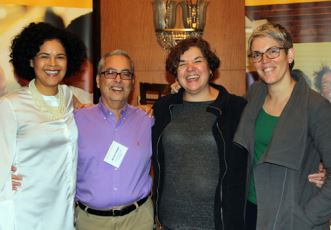
In the 2014 report, the Casey Foundation saw that the network scored lowest in the “racial equity and inclusion” category. The foundation responded by engaging more technical assistance providers with racial equity expertise to partner with organizations on deepening their understanding of equity and embedding it into their organizational culture and work. At the same time, it recognized that building this type of capacity takes time.
“Racial equity and inclusion are not just technical work,” Jackson said. “It requires adaptive leadership at the personal, organizational, and systemic levels. We can read all the books and know the history and structure of racism in America, but until we change our views and behavior, whatever we do will not be sufficient. The work is never done.”
Nonetheless, KIDS COUNT organizations are making progress. The 2016 report showed that they were generally stronger than they had been two years prior, with some of the greatest gains in competencies related to racial equity and inclusion. The report also showed that in eight out of 10 cases, intensive technical assistance investments were correlated with above-average improvement in the related competency, indicating the value of technical assistance like coaching and individualized capacity-building support.
From 2014 to 2016, there was a more than two-fold increase in the number of organizations undergoing a leadership transition, highlighting the need to provide readily available resources for new leaders and organizations undergoing meaningful change. The Casey Foundation used this data to shift its practices, designing a New Executive Director Boot Camp, an immersive learning experience for new directors.
The reports also showed correlations between certain competencies. For example, there was a correlation between “strategic leadership and decision making” and all other competencies: if an organization was performing well or poorly in this category, it likely had similar scores in other competencies. The data indicated that investing in strategic leadership and decision making are most likely to lead to ripple effect improvements in other competency areas. This finding strengthened the foundation ’s commitment to the leadership and decision-making support it provided, including an 18-month leadership program it provides to cohorts of grantees.
Data also showed that investments in certain competencies were leading to greater impact. Organizations that assessed themselves as effective in “policy advocacy and engagement” were successful in advocating for significantly more public dollars for public services reaching significantly more children and families as those whose scores indicated they were not as effective. Organizations that saw themselves as strong in “strategic leadership and decision making” were especially successful.
“These findings show that stronger advocacy capacity can influence high-level policy decisions, impacting the well-being of children and families,” Campa said.
In addition to informing the Casey Foundation’s capacity building investments and approach, the data also led KIDS COUNT network members to make their own changes. For example, the Children’s Alliance’s results informed its strategic planning process and even equipped staff to advocate for changes: two team members used the results to convince the organization to invest in a grant writer and researcher.
For the Arkansas Advocates for Children and Families, another KIDS COUNT member, the data highlighted an opportunity for growth in racial equity competencies. “The capacity indicator assessment was a major initial factor in pushing us to do much of the racial equity work we have done with staff over the last two years and in creating a greater equity lens in our policy and partner work,” said Rich Huddleston, executive director of Arkansas Advocates for Children and Families.
Since receiving the assessment results and recommendations, Arkansas Advocates for Children and Families has begun incorporating more of a racial equity lens into their research and communications, disaggregating data by race and paying more attention to the systemic and historical factors that impede racial equity in how they think about and frame issues. The assessment results impacted the organization in other significant ways, too: The data helped guide the development of a five-year strategic plan that the organization is now beginning to implement.
What Comes Next
The KIDS COUNT network is already reaping the benefits of this capacity building approach. After the 2016 U.S. presidential election, many of the network members found
themselves engaged in urgent advocacy efforts as they asked policymakers to preserve the Affordable Care Act which enables millions of American families to have health coverage. They also responded to various policies that threatened the stability of children in immigrant families. The Casey Foundation believes that the targeted capacity building that took place over the prior years helped equip organizations to respond quickly.
“We helped strengthen the network before the flood of policy threats began,” Jackson said.
The capacity-building work has had myriad benefits, strengthening network members while also strengthening the foundation’s relationship with them.
“This process has put us in a closer partnership with our grantees—the people who want a brighter future for kids and families,” Campa said. “Giving them the tools they need to accelerate that work means they can be more effective in accomplishing that mission.”
“The staff really do care about making you a better organization so they’re very hands-on, always looking for opportunities within the Casey Foundation structure to get more resources to help you get the work done and build your capacity,” Huddleston said.
Going forward, the foundation said it is exploring plans to make the Advocacy Learning Lab a public website available to any organization that might benefit from it. The foundation also organized a second national racial equity institute in 2018—almost entirely designed by the network and open to members of KIDS COUNT, the State Priorities Partnership, and Partnership for America’s Children—to build on one that took place in 2016. The assessment has even extended beyond the network: It has been adapted by other state-based networks, the State Priorities Partnership (a project of the Center on Budget and Policy Priorities) and the Partnership for America’s Children. The next KIDS COUNT assessment is scheduled to take place in 2019.
“The KIDS COUNT partnership has been an immeasurable asset for us for more than 25 years,” said Joan L. Benso, the former president and CEO of Pennsylvania Partnerships for Children, a KIDS COUNT network member. “In no small part, the strong progress we have made for children in our state is steeped in an advocacy case that relies on the capacity we’ve been able to build.”
Discussion Questions: Use these questions to spark discussion within your own
foundation to explore ways you might be able to support your grantees’ capacity to advocate for public policy change.
- What from the Annie E. Casey Foundation’s story resonates with what we have learned from our work with grantees? What about their approach is different from
what we have done in the past? What is something we might consider trying based on this approach? - Why do or don’t we support nonprofits’ advocacy work? How might we increase support for grantees’ advocacy work in order to help us accomplish our mission?
- What are our grantees’ needs related to advocacy, and how do we know? What are we already doing to support them, and how might we ramp up those efforts?
- Where are our grantees in their work related to racial equity? How might we tailor support to meet grantees where they are and help them take their next steps in this work?
- Who are the service providers we rely on to help build capacity among grantees, and where are the gaps? What are grantees’ respective capacity needs, and how might we support them?
